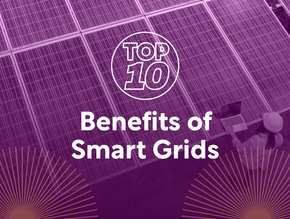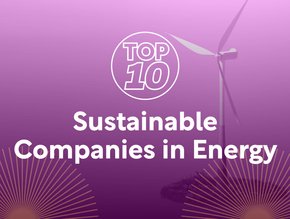
As the energy transition continues to accelerate, innovative infrastructure projects play their part in reshaping the global energy landscape by facilitating influential schemes that once could only be dreamt of.
These projects tackle growing climate issues, ensure energy resilience and pioneer engineering of the highest standards, displaying critical thinking and the desire to ensure a more secure energy future for all.
In this week’s Top 10, we explore the top 10 energy infrastructure projects driving progress and paving the way for a cleaner, more resilient future.
10. Emasesa Biogas Pilot
Location: Seville, Spain

Affirming Seville’s place as a role model of sustainability, the city’s Emasesa Biogas Pilot turns the nuisance of more than 5.7m kilos of bitter oranges being dropped onto the city’s streets in the winter months from its 48,000 trees into a positive. How, you ask? By using the methane produced during the natural fermentation process to produce electricity.
Seville-based water company Emasesa is behind the project and uses 35 tonnes of fruit to generate clean energy to power one of the city’s water purification plants. If the utility can invest €250,000 (US$267,800), its Head of Environment Benigno López hopes it can recycle all the surplus oranges in Seville, enough to power 73,000 homes.
9. Madhya Pradesh Floating Solar Array
Location: Madhya Pradesh, India
The world’s largest floating solar plant, the project on the backwaters of Omkareshwar Dam was hit by a storm ahead of its opening this month but is still anticipated to be an era-defining installation. It boasts unique technology much like those seen in hydroelectric power plants which enables the generation of electricity from water.
The US$410m array has floaters positioned on the water's surface which are connected to solar panels. Said floaters are connected to safeguard from potential harm from fluctuations in water flow or level. As it stands, the first phase generates 600MW, with potential for the project to be further expanded.
8. Redstone
Location: Northern Cape, South Africa
A first of its kind on the African continent, the Redstone Solar Thermal Power Project in Postmasburg is said to be the largest renewable energy project in South Africa. It has powered more than 200,000 homes and secured employment for more than 4,000 people. Since its inception it has not released any carbon emissions as its unique solar and storage technology does not require any natural gas backup. Thanks to its energy storage capabilities, 480,000GWh of electricity is produced annually, more than twice as much net annual output than an equivalent sized PV solar project. Redstone is a large supporter of South Africa’s decarbonisation efforts, as well as its socioeconomic growth, thanks to its ability to displace around 440 metric tons of carbon emissions per year and creating more than 2,000 construction jobs.
7. Baihetan Hydropower Station
Location: Sichuan Province, China

Formally completed in December 2022 when the final hydro-generating unit was connected to the grid and began producing power, the Baihetan Dam generates power through 16 turbines, each with a generating capacity of 1GW, taking the generating capacity to 16,000MW. Although surveying of the dam site was completed 30 years prior, the hydropower station started partial electricity generation in 2021. Now fully operational, the hydropower station generates 60.24 TWh of electricity and offsets more than 51m tons of carbon emissions. It’s also a record-breaker, with the US$34bn station hosting the largest underground caverns, anti-seismic parameters and spillway caverns.
6. SparkMeter Digital Solutions
Location: Worldwide
A smart grid startup backed with a US$12m infusion and led by Bill Gates’ Breakthrough Energy, SparkMeter uses data analytics and technology to help providers in underserved communities strengthen access to electricity and mitigate carbon emissions. CEO Daniel Schnitzer said: “Our software and meter analytics help co-op utilities manage line balancing, voltage drops and transformer capacity availability, in addition to digitising their billing and payment processes. All together, these solutions help utilities integrate more renewables into their grids through better grid management and provide better service to their customers.”
5. Experimental Advanced Superconducting Tokamak
Location: Anhui Province, China
An experimental superconducting tokamak magnetic fusion energy reactor, The Experimental Advanced Superconducting Tokamak (EAST) is an experiment being conducted by the Hefei Institutes of Physical Science for the Chinese Academy of Sciences. It has been operational since 2006 and holds significant influence in the energy landscape due to its pioneering efforts in fusion research.
It acts as a key project in China's quest for sustainable energy by exploring the potential of nuclear fusion as a clean and abundant power source. In May 2021, it hit a new world record when its nuclear reactor held 120 million degrees Celsius for 101 seconds. China's US$1tn 'artificial sun' fusion reactor is actually five times hotter than the real thing and replicates the nuclear fusion process that occurs naturally in the sun and stars.
4. Hot Heart
Location: Helsinki, Finland

Looking like something out of a futuristic Hollywood blockbuster, Hot Heart — a floating archipelago of basins that act as giant thermal batteries — uses an AI-fuelled system to synchronise energy production and consumption. Its 10 cylindrical basins each measure 225 metres in diameter and collectively hold up to 10m cubic metres of water.
Its dual function of providing thermal energy storage is balanced with its role as a hub for recreational activities. Hot Heart won the Helsinki Energy Challenge, which aims to decarbonise the heating system of the Finnish capital by 2030. It is an international collaboration borne from the expertise of energy experts including Schneider Electric, Ramboll and Danfoss Leanheat.
3. Al Dhafra Solar Photovoltaic Plant
Location: Abu Dhabi, UAE
One of the largest single-site solar PV plants in the world, the 2GW Al Dhafra Solar project was announced by the Abu Dhabi Electricity and Water Authority in 2020. The landmark project in the Abu Dhabi desert spans more than 20 sq km is spearheaded by the Abu Dhabi National Energy Company (TAQA) and was developed in collaboration with global partners, including Masdar and EDF Renewables to advance the UAE's renewable energy goals and diversify its energy mix away from fossil fuels, something the country has built its wealth on. The plant powers around 160,000 homes and reduces carbon emissions by more than 2.4m tons each year.
2. Andes Renovables
Location: Antofagasta, Atacama, Bio-Bio and Los Lagos regions, Chile
Comprising ten projects — seven wind and three solar — as well as an investment of US$1.8bn, Andes Renovables is one of the largest renewable energy initiatives in Latin America. It’s anticipated to supply 1.3GW of clean power, the equivalent needed to power 20% of Chile’s homes. Chile’s National Energy Commission awarded Mainstream Renewable Power a 20-year index-linked, US dollar-denominated contract, to supply 3,366GW/h of firm power starting from 2021.
“We aim to be a relevant player in Latin America's energy transition through the development, construction and operation of large-scale renewable energy projects, which include wind and solar technology, and the development of green hydrogen as well,” said Mainstream’s General Manager of LATAM Manuel Tagle.
1. Energy Island
Location: North Sea and Baltic Sea, Denmark

Two large-scale offshore wind farm projects the government of Denmark is planning to establish by 2030, this energy-first approach to wind power is a leap on from the country establishing the first offshore wind farms more than 30 years ago. These man-made patches of land are expected to generate enough wind power for the country’s entire grid, plus that of other parts of Europe.
The purpose-built site is the largest construction feat in Denmark’s history and is a clear indicator of the contributions it has made to global sustainability. The project increases the country's total offshore wind energy capacity fourfold, and up to sevenfold when all phases are completed.
"This is gigantic and the next big step for the Danish wind turbine industry,” said Professor Jacob Ostergaard of the Technical University of Denmark.
“We were leading on land, then we took the step offshore and now we are taking the step with energy islands, so it'll keep the Danish industry in a pioneering position.”
*******************
Make sure you check out the latest edition of Energy Digital Magazine and also sign up to our global conference series - Sustainability LIVE 2024.
*******************
Energy Digital is a BizClik brand.






